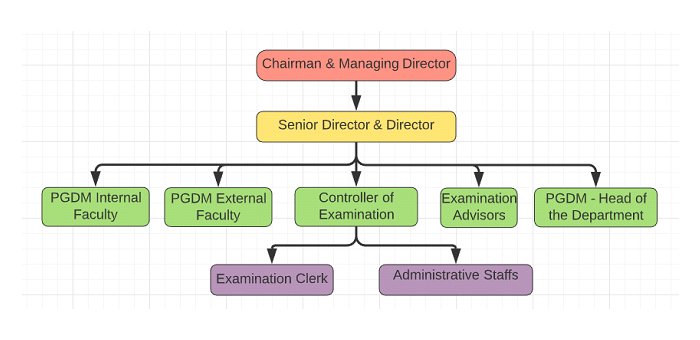PGDM
Introduction
SKIBS flagship PGDM programme is a two-year full-time programme. This programme is considered extremely prestigious and is highly rated. This PGDM programme facilitates both in theory and in practice of different functional areas of management. Apart from these various expert sessions are given as an input to the students admitted in PGDM.
PGDM Course Structure and Credit System:
The course comprises of 4 components namely Core subjects, Summer Internship Project Report (SIPR), Elective subjects and Dissertation.
The first year in the PGDM Programme comprises of 18 compulsory courses which are common for all students which carries 59 credits and is spread across two semesters.
After second semester the students must compulsorily undergo two months of summer Internship and has to submit the organization study report in 3rd semester which also included Viva-Voce for the same and this SIPR carries 6 credits.
In the second year the students will have 3 core subjects plus 10 elective subjects which will be shared among two semesters i.e., Semester III and IV which comprises of 52 credits.
And the final 4th component is dissertation (Project) which the student will do a research work on their specialization which comprises of 8 credits.
Examination Committee
The Examination Committee members structure is as follows:

Examination Schedule
After discussion made with the above committee members the date of examination will be fixed for the respective semesters and will be communicated to the students well in advance usually a month before the examination. Soon after the announcement within 10 days the Time Table or schedule of examinations will be shared with the students through circular.
Examination conducting procedure
Minimum 75% attendance is required to attend the term-end examination.
After the announcement of exams, the Board of Examiners will identify 3 faculty for each subject for the preparation of question papers.
The internal and external faculties will be selected on the criteria of subject knowledge, experience teaching the subject etc.
There will be a last date provided to all faculty within which they have to submit the prepared question papers.

The faculties selected will be explained on Bloom’s Taxonomy and will be asked to follow the same while preparing the question paper. The figure below explains the steps on Bloom’s Taxonomy.
Then the scrutiny members will be checking for the coverage of syllabus in the question paper and also will make sure that the concept of Bloom’s Taxonomy is followed in the question paper preparation.
Students will have to register themselves for the examination soon after the call-for including the regular and repeater papers.
Student will be periodically assessed by the project guides for Summer Internship Project and Final Dissertation Project. Submitting the report on time and attending the Viva-Voce for both is mandatory for the student to be eligible to get the PGDM degree. Failing which will be considered as fail and have to appear for the same only the next year.
Student who have failed in the theory papers will be allowed to appear in the immediate next semester.
Before 2 days of examination, the hall ticket will be issued to the students.
There will be the circular on "Instructions to Students" for the examination which will be placed on Notice board before 2 days of the examination.
The seating arrangement will be put on the notice board on the day of exam and students are strictly asked to adhere to the same.
Instructions to Invigilators will also be shared with all faculties.
After the completion of every exam, the answer booklets will be bundled, packed and kept in the dark room.
Evaluation Procedures
There will be two evaluators fixed based on the criteria for a paper.
The evaluators will be asked to fix their appointment and come for the evaluation.
The average of the two evaluations will be considered as the final external marks.
The Grades and the Grading System is mentioned under the next heading
Evaluation Pattern, Grades and Grading System
Evaluation Pattern for each of the subjects will be as mentioned in the below table.
| Components | Weightage (Marks) |
|---|---|
| Attendance | 10 |
| Case Analysis / GD / Assignments | 10 |
| Surprise Assignments/Presentations | 10 |
| Mid – Term I | 15 |
| Mid – Term II | 15 |
| Term- End | 40 |
| Total | 100 |
Students will write their external exam for 70 marks which will be converted for 40 and will be taken for the Term-End marks.
Grading System
(a) Each course is assigned a letter grade on a ten-point scale using the following letter grade, grade points and range of marks.
| Percentage of Marks | Letter Grade | Grade Point | Interpretation | Class |
|---|---|---|---|---|
| 90% and Above | A+ | 10 | Outstanding | Distinction |
| 80% to 89% | A | 9 | Excellent | |
| 75% to 79% | A- | 8 | Very Good | |
| 70% to 74% | B+ | 7 | Good | First Class |
| 60% to 69% | B | 6 | Above Average | |
| 50% to 59% | C | 5 | Average | Second Class |
| 40% to 49% | D | 4 | Satisfactory | |
| Below 40% & Absent | F | 0 | Fail |
Grade ‘A+’ to ‘C‘ indicate successful completion of the course
GPA = ∑(Ci * Gi) / ∑(Ci)
CGPA = ∑ (Ci * Gi of all semesters) / ∑ (Ci of all semesters)
Where,
C = Credit Points of the course
G = Grade Point of the course
CGPA is the sum of overall courses in all the semesters. UA are taken into account for calculation. It is rounded off to two decimals.
Declaration of Results
After all evaluation, the Controller of Examination will work on the conversion of grades, grade points. Once all the marks calculation is completed there will be a thorough check on the mark’s entry and calculation.
Then the results will be discussed with Director and will be declared to the students.
